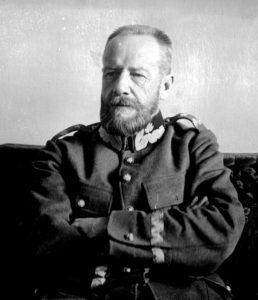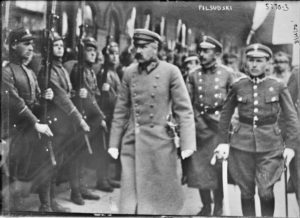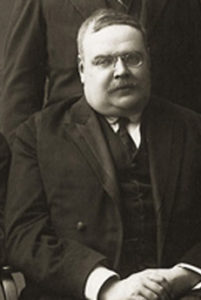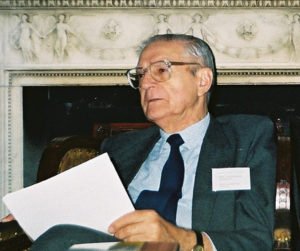“Lithuanians are a small but very proud nation. Looking down at them or dismissing them is bound to antagonize the Lithuanian public opinion right away”, says Alfredas Bumblauskas from the Vilnius University. What should foreigners know about Lithuania to better understand Lithuanians? Read our interview about complicted Polish-Lithuanian common history!
polishhistory: Both Poland and Lithuania are heirs to the Polish-Lithuanian Commonwealth. After World War I that heritage became a basis for the eastward shift of the Polish border. What was the Lithuanian attitude to the Commonwealth’s legacy and how did Lithuania envision itself in 1918 and 1919?
Alfredas Bumblauskas: Lithuania regarded the Polish interpretation of that heritage as imperialism, not only cultural, but also political. It was believed in Lithuania that the Commonwealth was not a unitarian state after the Union of Lublin. The unitarianists’ historiographical line was regarded as erroneous, with the federalists’ interpretation viewed much more favorably. Championed by Oskar Halecki, the latter became well-established in our time by Juliusz Bardach. It was generally thought that as the Commonwealth constituted the two nations’ common good, their separateness should be recognized in the same way as each spouse’s subjectivity is respected. In Lithuania there has always been the fear that Poland respects the rights of only one spouse, and this fear persists. Let us bear in mind that when Polish politicians refer in their speeches to pre-war Poland, they use the term the ‘Second Republic of Poland’. Why do they call it the second one? Why, the First Polish Republic was not exclusively Polish. Lithuanians are slightly less bold in this respect than Poles. For instance, the leading figure of the Lithuanian revival, Vytautas Landsbergis suggested saying Polish-Lithuanian Commonwealth and, in reference to the post-1918 state, Interwar Lithuania. So a certain a difference can be seen here.

So Lithuanians regarded the shared heritage as monopolized by Poles?
Yes, but at the same time it must be stressed that the Polish language was the common language in the Polish-Lithuanian Commonwealth, which Lithuanians do not like and which they sometimes refuse to admit. Some voices in Lithuanian historiography go even as far as claiming that while the national revival of Lithuanians in the 19th century was aimed at distancing them from tsarism, what it actually did was take them much further away from Polish culture, in which they had been immersed for a long time. It is being debated whether that did not perhaps bring more harm to the Poles and Lithuanians than to the Russians.
One of the main bones of contention between the two countries is the issue of the border. How did independent Lithuania envision it? Probably not according to the ethnic criterion because then the Vilna region would have been excluded, and not according to the criterion of the historic borders either because the Lithuanians did not lay claims to the Belarussian lands which were a part of the Great Duchy of Lithuania…
The modern conception of Lithuanian borders was created by Lithuanian diplomat and historian Petras Klimas. Lithuanians usually say that this is the only proper border in the east. It does include Vilna; it goes from the River Niemen tributary — Berezina or Biarezina (not to be confused with its more famous namesake, that is, the River Berezina flowing further east, through Babruysk and Barysau), then runs along the River Niemen and Maladziečna, and finally reaches Braslaw and the River Daugava. The line of division was such that individuals of Catholic faith were to be regarded as Lithuanians. It was thought that inhabitants of the areas where Catholicism was dominant were Lithuanians. That conception was proposed to the Soviets by Petras Klimas. The Bolsheviks were very much in favor of it in July 1920, particularly that on the eve of the planned international revolution, which would have also encompassed Lithuania, giving away such a small piece of land did not pose a problem. The marking out of the Polish border in the 1921 Treaty of Riga was guided by similar considerations. The Polish claims clashed with the Lithuanian ones in that regard. That issue was finally settled by Żeligowski’s Mutiny, the establishment of Central Lithuania and its incorporation into Poland.

How can the influence of Żeligowski’s Mutiny on the Polish-Lithuanian relations be assessed from today’s perspective?
At that time it constituted the main problem in the Polish-Lithuanian relations, but as a matter of fact its consequences are felt even today. How should Żeligowski’s act be evaluated? — this is a question addressed to contemporary historians, both Polish and Lithuanian. Today we know that Piłsudski was behind it, which he did admit and which Lithuanians hold against him, even today, when they understand that if it had not been for Piłsudski, the year 1920 and the Battle of Warsaw, Lithuania would have become a part of the Soviet Union back in 1920. But this is not enough to change the way Piłsudski is regarded. Piłsudski has long been regarded as an occupier.
Let us digress here to understand his relations with Lithuania. I have read a book penned by a Lithuanian journalist of Polish descent, Jerzy Surwiło, entitled Wileńskie Ślady Józefa Piłsudskiego [traces of Józef Piłsudski in Vilnius]. I learned from it that all of Piłsudski’s great-grandparents came from Samogitia, and from outside of its traditionally Polish parts at that, for instance, Vilna or Švenčionys. The Piłsudski family were Samogitia noblemen, same as the family of his mother — the Billewicz family. Lithuanians are slowly beginning to acknowledge this fact, and their attitude towards Józef Piłsudski is changing. At his birthplace there is a plaque where he is referred to as Juozapas Piłsudskis, not even Józef but Juozapas. This is a manifestation of the change of consciousness, which has actually echoed rather far and wide.
Let us return to Żeligowski. He too claimed that he was not going for anything that was not his.
Yes, because he was an Ashmyany nobleman from the Vilnius region. Many people who accompanied him then were from Lithuania or even its Samogitia region. This means that in the case of Żeligowski’s Mutiny one can really advance a thesis about the civil war that was to decide the future fate of Lithuania. The issue of social support for Żeligowski is yet to be investigated. The moods and the scale of the divide can be aptly illustrated with a story from the Babtai– Kėdainiai–Vandžiogala triangle, which was located beyond Kaunas, in the direction of Panevėžys. At a local starosty seat a petition was drafted asking Piłsudski for rescue from the Kaunas Taryba. The document was signed by not only the Polish-speaking nobility, but also people of non-noble descent, the total of over 2,000 signatories. That document was sent to Piłsudski from the center of Lithuania, from the Kaunas area! We have yet a lot to learn about the Lithuanian identity during that period. In my opinion, the claims that Piłsudski arranged Żeligowski’s Mutiny and cynically captured Vilna because that was where he came from and because he could not live without that city are false. The objective was entire Lithuania. The real question was: how to live with that part of the old Commonwealth which suddenly had a problem with Polishness? Piłsudski’s main objective was to unify the old Commonwealth in the face of the Bolshevik threat.

After Vilna’s incorporation into Poland the two sides entrenched themselves on the enemy positions but even then many people wished for some reconciliation. One of them was Stanisław Narutowicz. From today’s perspective it is relatively strange that a brother of the first Polish President was a signatory of the Lithuanian declaration of independence.
It seems unusual only at first glance. The number of such people originating from the nobility was much larger. Among them were, for instance, Michał Römer, the Tyszkiewicz family, or the Plater family. Stanisław Narutowicz is known for signing the declaration of independence, but among its signatories there were others like him, for instance, Donatas Malinauskas also came from the Polish-speaking nobility. Those people expressed their identity in various ways. Michał Römer said: “I am a Polish Lithuanian.” There was also another formula for defining that identity — “we are Old Lithuanians.” Walerian Meysztowicz said the following to New Lithuanians: “I am a Lithuanian, Jogaila was a Lithuanian, Piłsudski is a Lithuanian, and you are Lietuvisy.” I always ask who should actually be regarded as Lithuanian — only the New Lithuanians? Or the Old Lithuanians too? Old Lithuanians can be found even today; let us take, for instance, the Radziwiłłs — Maciej and Mikołaj. When I gave a lecture at the Constitutional Tribunal one of them approached me and said that it was the first time that he thought about his identity in that way, that is, in terms of his being an Old Lithuanian. Similarly, the late Professor Stanisław Aleksandrowicz from Toruń also used to say that he was “a Lithuanian of a Mickiewiczian composition.” This is precisely the type of a Lithuanian Żeligowski was. One of the first books those people had contact with was Mr Tadeusz, which reads, “Lithuania! My Homeland!”
Let us look at Stanisław Narutowicz in this context. He comes from the same area as my father’s family. He told me that Narutowicz was referred to as ‘Naruta’, in the Samogitian fashion, that is, without the suffix –wicz, which, similarly as –ski, ennobles a surname. By the way, his family is a very interesting case because it is also descended from the Billewicz family, which means that it is related to Piłsudski. Their family used to say that that they were ‘Lithuanian Poles’. Consequently, they fell into the same category as Michał Römer.

As we can see there were many people like Narutowicz. Their stances differed, from loyalty to the New Lithuanian state to cooperation with Poles.
Did that cooperation encompass actions against the government in Kaunas?
It remains unclear whether — and if so then how — Piłsudski planned to make Narutowicz his agent of influence in Lithuania. Narutowicz participated in three secret meetings devoted to the possibility of organizing a mutiny against the Kaunas government. I do not know what Narutowicz thought about that possibility or the government in Kaunas. But this proves that Piłsudski understood that it was important to involve in Lithuanian matters people from Lithuania who were not prejudiced against the Polish culture or language.
How was the year 1939 received in Lithuania? Did the joy from the recovery of Vilna dominate over the anxiety caused by the nearing Soviets?
Those two sentiments were concurrent. On the one hand, the dominant slogan during the interwar period was: “We won’t rest until we recover Vilna.” Consequently, there was certain gratitude towards the Soviets. A lot of bad things were forgotten, with many Lithuanians, not only communists, having a positive attitude towards the Soviets. On the other hand, certain doubts appeared right away — famous musician Petras Biržys, known as Pupų Dėdė, sang: “Vilna is ours and we are the Russians’.” Everybody realized that the end of Lithuanian independence was near. The events in the incorporated Vilna region are interesting too. The Lithuanian government, which spent the interwar period in Kaunas, began to terrorize the Vilna region using policemen who did not speak Polish. The Stefan Batory University was brutally closed down. That sparked protests in Vilna. The winter of 1939 was very cold so there was the issue of finding accommodation for the dismissed professors. And that antagonized the Kaunas Lithuanians and the Vilna society. Martial law was introduced on the territories inhabited by Poles. One can see a major change in the attitude — in 1920 Mykolas Biržiška said: “How to Lithuanize Vilna? The first rule is: do not. The second rule is: keep people from Kaunas who cannot speak Polish, including civil servants and policemen, away from Vilna.” But twenty years later times were different and there was no intention to compromise. Józef Mackiewicz, a famous Vilna journalist, said to wait for the Soviet invasion because even the Soviets would treat the Polish population in a more lenient way. By contrast, the Lithuanians wanted to Lithuanize Vilna using simple and brutal methods.

The 20th-century Polish-Lithuanian history was not easy, also after the second reinstatement of Lithuanian independence in 1991. There were better and worse periods in our mutual relations, for instance, there was the major dispute over the Poles’ autonomy.
There is a certain contradiction deeply rooted in the Lithuanian debate. There is this conviction that the Vilna region is inhabited by the Polonized Lithuanian element, but in fact the Vilna region resembles a black hole — nobody fully understood what was happening there or how it worked. Nobody analyzed that in detail. The Sąjūdis movement operated in 1988 and 1989. Not only Lithuanian, but also Polish flags were waved during demonstrations. That potential for reconciliation and cooperation was wasted though, with probably both sides to blame. The Sąjūdis line was rather New Lithuanian in character, and thus not prone to a compromise. But on the Polish side there were also many people who in practice realized the interests of the Kremlin.
The origin of the idea of the autonomy remains unknown. One of its versions even envisaged an autonomy within the framework of the USSR, that is, an autonomy from Lithuanian independence. Later a different project envisaged an autonomy for the Poles within the framework of Lithuania. That was a better idea, but it came too late, for the Poles had not been forgiven for the idea of the autonomy within the USSR’s framework. That situation lasted until 1993 when the government in Vilna began to seriously consider tightening its relations with NATO and the EU. At that time certain Lithuanians realized that without cooperation with Poland Lithuania would not stand a chance to enter the NATO and European structures. That was when Giedroyc and Brzeziński became ‘trendy’, and with time that trend began to yield results. While in 1991 one could see graffiti “Hitler=Stalin=Piłsudski,” they disappeared after 1993. The situation was gradually improving, with Polish activists, such as, Czesław Okińczyc, becoming genuine authorities in Lithuania.

We are having this conversation in Warsaw, which you are visiting because you have received the Polish-Lithuanian Forum for Dialogue and Cooperation’s award for promoting Lithuanian history. One has to ask: what lesson can Poles learn from Lithuanian history to foster our mutual relations? What should foreigners know about Lithuania to understand Lithuanians?
It is a difficult but important question. First of all, one must know that Lithuanians are a small but very proud nation. Looking down at them or dismissing them is bound to antagonize the Lithuanian public opinion right away. This is not to say that one should always make concessions, but if one treats them tactfully and politely, a consensus can always be reached. I think that Poles and representatives of other countries should learn Giedroyc and Mieroszewski’s approach. The two of them clearly state that inasmuch as the Polish culture is attractive, forcing it is bound to cause resistance. The same applies to Norwegians and Danes, Fins and Swedes, Czechs and Germans, etc. It is more or less the same everywhere. The dominant nation sometimes has to give ground, some degree of freedom, and help younger nations, such as, Ukrainians, Belarussians, or Lithuanians, create their own, full-bodied culture.
When I was begining to study history we were taught that Poland would not cede the history of the Commonwealth to Lithuania. It was remarked that the Polish-Lithuanian state was called ‘Republic of Poland’ even in reference to the 15th century. But with time it occurred that the Giedroyc line became accepted by most Polish scholars of Lithuania. All major figures in Polish historiography, such as, Juliusz Bardach, Aleksander Gieysztor, Henryk Wissner, or Jerzy Ochmański, had a favorable attitude to Lithuanians’ drawing from our shared history. They even appeared to be asking us: “Why do you not draw from this history? It’s yours!” That was something new to us.

Poland and Lithuania went their separate ways in the 20th century. Poles should understand that Lithuanians do not consider themselves inferior in civilizational terms, though they used to because the baptism of Lithuania was delayed by 400 years. It is a long period of time. The Cistercians were present in Poland as early as in the 11th century, compared to the 15th century in the case of Lithuania. I like to repeat what Americans say when they defend the claim that their policy is not imperialism. They say: “we are not powerful with the power of our imperialism but with the power of our duties.” I wish this conviction to all nations which, like Poland, emerged from history with a great legacy and potential.
Interviewer: Jan Malesza
Translation: Jerzy Giebułtowski





